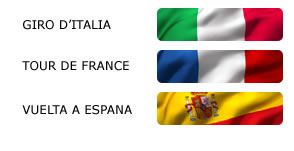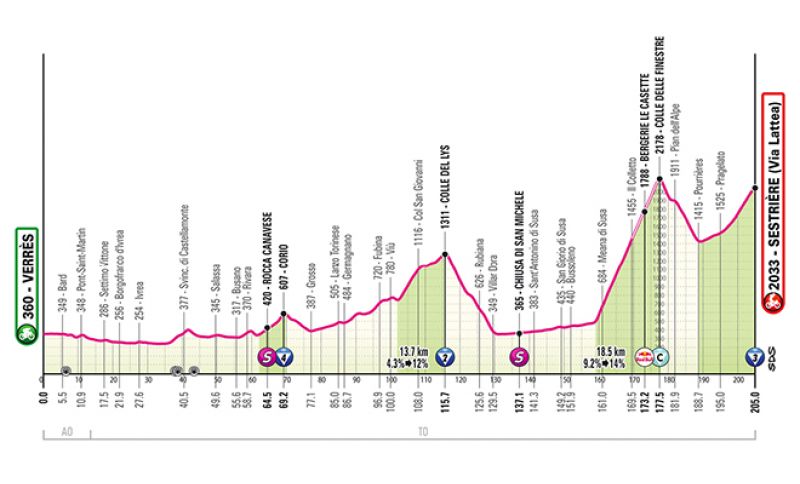

The stage without a tomorrow has arrived: the final stage in Rome will be a splendid parade, but today in stage number 20 the history of this Giro will be decided. On the program is the Verres-Sestriere of 205 km with 4,500 meters of elevation gain.
To follow the live coverage of the entire stage starting at 10:45 AM CLICK HERE
The stage presents a first flat section until entering the Canavese area, followed by a series of more or less short and challenging climbs that lead to the Lanzo Valleys where, after passing Viù, the Colle del Lys climb begins. Then descending into the Dora Riparia valley to reach Susa where the Colle delle Finestre climb starts.
The Colle delle Finestre (Cima Coppi) has a practically constant gradient of 9.2% from start to finish (with a short steep section at Meana di Susa max 14%) and the first 9 km are paved, while the next 9 km are unpaved to the summit. During the first part of the climb, there are 29 hairpin turns in less than 4 km (up to 45 hairpin turns to the top). The descent is very challenging, narrow, and exposed in the first part until Pian dell'Alpe. Once back on ss.23, the climb resumes with accessible gradients until the finish.
The last kilometers are all on ss.23 with a slight uphill (5% average) with a wide and well-paved road.
THE TERRITORY. The unmistakable silhouette of Verres Castle protects the town and the Val d'Ayas from a rocky spur, as it has for over 700 years. Before the stage's start, it's worth visiting this unique square-plan structure that tells important pages of Valle d'Aosta's history.
Ivrea also boasts a powerful fifteenth-century castle, called the Castle of Red Towers due to its four massive towers protecting its perimeter. After a long restoration, it was reopened to visits just a few months ago, guaranteeing a novelty effect. Then it's time to celebrate contemporary Ivrea at the MaAM (Open-Air Museum of Olivetti Modern Architectures), a path of about 2 kilometers inspired by the history of the Ivrea company that paved the Italian way to new technologies in the last century.
Then crossing the Canavese, stopping in Castellamonte, one of Italy's ceramic capitals. A notable Ceramic Museum is dedicated to the skill of local artisans, while the medieval-looking Castle elegantly narrates past splendors.
In Lanzo Torinese, you start to breathe mountain air at the Alpinism History Ecomuseum of Lanzo Valleys, where you can admire skis from various eras, wooden snowshoes, rock climbing equipment, ice axes, and many other historically valuable objects.
After passing Viù (where you can see Rotondarte, the permanent contemporary art exhibition in Villa Franchetti Park) and Colle del Lys, you descend into Val di Susa. Immediately filling eyes and heart is the Sacra di San Michele, dominating the valley from a rock wall above Chiusa. Built just before the year 1000 as an expression of salvation needs crossing the Christian world, it knew its maximum splendor in the 12th century. As proof of the place's importance, the Piedmont Region elected this site as its symbol a few years ago.
The climb towards Colle delle Finestre, the place where the stage will likely be decided, allows a glimpse into Val Chisone. The finish is near, but once on the valley floor, a brief deviation from the race route is mandatory to admire the incredible Fenestrelle Fortress. Built starting from the 18th century, it's the largest fortified structure in Europe and climbs entirely along the mountain side: 4000 steps must be climbed to reach the highest defensive structures.
Finally, here is Sestriere. On the Pass at 2,033 meters, everything speaks of sport. The memory of the 2006 Winter Olympics is still alive, but this has always been cycling territory. This is testified by the monument dedicated to Fausto Coppi, protagonist of a memorable feat in 1952.
